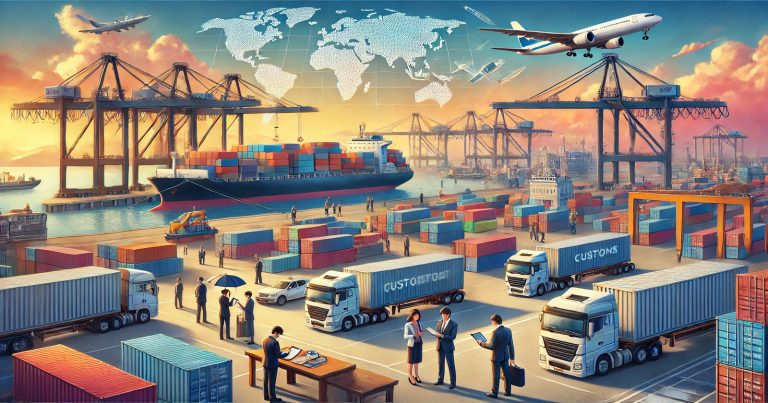The import-export procedure is one of the best business methods when exchanging goods across international borders. The process ensures that business is smoothly operated through various rules, customs requirements, and strict application of proper logistics schemes. The license approval is completed by incorporating all the necessary documents in the import-export process. This includes customs withdrawal and appropriate shipping methods. Import and export regulations differ in various countries, and businesses must observe them to avoid potential legal and financial risks. The import and export process is the most vital in international trade, in which a company can sell products in any country with efficient importing processes from other countries.
Import Export Procedure
The import-export procedure is a step-by-step process for legally transporting goods between business countries. Each step is carried out with appropriate documentation, customs authorization and logistics management. Consequently, companies avoid delays and excessive fines by properly carrying out all these necessary procedures.
1 Understanding the Trade Rules
Consequently, each country has its own rules of import-export, which require enterprises to carry out international trade. These import-export rules determine the restrictions that apply to each product and their customs duties, taxation, and safety regulations. Most products, such as chemicals, foods, and drugs, require critical approval before being transported across borders.
For example, India follows the export-import policy of India, which details trade policies, tariff structures, and permitted goods. Businesses must know the ever-evolving regulations so that they do not suffer due to fines and shipment rejections. They need to refer to government trade websites and consultants to ensure that their business operations do not go against any rule in trade.
2. Business Registration
Before attaching to international trade, businesses must legally register their company. In India, businesses require an importer-exporter code (IEC) issued by the Directorate General of Foreign Trade (DGFT). This allows unique code companies to trade on boundaries and is mandatory for all import-export activities.
In addition, companies must register under GST, which is a taxation rule. Certain sectors also require other industry-specific approvals, such as food safety certifications for exporting processed foods. Business owners must know all the legal necessities before importing or exporting.
3. Acquiring Required Licenses
Special licenses are needed to import or export certain products. These licenses help businesses meet the national safety and quality standards the nation sets. Licenses for import-export vary depending on the goods. For instance, agricultural products need phytosanitary certificates, and electronics may require BIS approval.
Businesses should check government websites or consult trade experts to determine whether they need additional licenses. Failing to obtain the required permit can ban the trade of customs rejection, punishment, or even specific goods. Companies should already request these permissions to avoid shipping delays.
4 Documents Preparation for Import Exports
export and import documents are required to clean the reviews and provide gentle transactions. Each cargo requires specific documentation, including detailed information about the goods, buyers, sellers, and logistics. Absolute or incorrect documents can lead to the fact that they are shipped, fines or judicial claims. The import-export documentation requirements include:
- Commercial Invoice: Provides details about the transaction, such as the buyer, seller, and payment terms.
- Packing List – Lists all the items being shipped, including their quantity, weight, and packaging details.
- Bill of Lading (BOL) – A legal document issued by the shipping company that serves as proof of shipment.
- Certificate of Origin: Check the country where the necessary goods were made to be exempted from the trade agreement’s obligations.
- Insurance Certificate: Protects against financial losses due to losses, theft or accidents during transportation. Companies must review all requirements in the documentation to ensure legal compliance for both importing countries and exports.
5. Customs Clearing Process
The customs license process is one of the most important steps in the import-export process. Customs officials inspect supplies to ensure compliance with tax laws, trade politicians and security regulations. Enterprises must submit the necessary documents, pay applicable duties and receive customs approval before their goods are sent or received.
For exports, the business filing must fill in a shipping bill to address the details of the goods, the exporter, and the shipment destination. Customs allow the importer to file a Bill of Entry to help calculate import duties and taxes. Customs authorities can also inspect shipments to see whether the cargo is within the goods declared.
Delays in customs clearance can disrupt supply chains and increase costs. Businesses should work with customs brokers or freight forwarders to speed up the clearance process and avoid compliance issues.
6. Choosing Appropriate Logistics and Freight
The transport of goods is an important aspect of the import-export process. Businesses should be carefully planned for their import-export logistics to ensure timely and cost-effective delivery. Choosing the right shipping method – whether from the sea, air, or land – the nature of the goods and destination depends on the nature.
Many businesses import or export using freight forwarding companies. Freight forwarders deal with packaging, clearing customs, shipping documents, and delivery tracking. With experienced freight forwarders, the risks involved are minimal, and transportation costs are also lowered, while the items are sure to arrive at the destination safely.
Shipments of goods, documentation, or improper handling may cause financial losses. A firm will look for a reliable logistics partner that provides competitive pricing, real -time tracking and smooth customs withdrawal support.
7. Methods of Payment For Import Exports
International trade requires safe payment methods to ensure that both buyers and sellers are preserved. Import-export includes normal payment methods:
- Letter of Credit (LC) – A bank acts as an intermediary and guarantees payment once the exporter fulfils contract terms.
- Advance Payment: The importer pays the full amount before shipping goods.
- Open Account: The exporter sends goods first, and the importer makes payment after receiving the shipment.
- Documentary Collection: The exporter’s bank collects the payment from the importer before shipping documents are released.
The right pay mode reduces financial risk, fraud prevention, and timely transactions. Exporters should deal with reliable banks to have a smooth effect on payments.
8. Import Export Clearance Process
The import-export clearance process involves verifying documents, assessing import duties, and inspecting goods before allowing shipments to enter or leave a country. Customs officials check whether shipments comply with trade regulations and taxation rules.
Importers must pay import-export duties and taxes based on the type of goods and the country’s tax laws. Some goods may request exemption by trade agreements and import-export policies. The correct compliance ensures that companies can clean customs without unnecessary delays. Working with experienced customs agents can simplify the release process. Companies should always check the latest policies and customs rules to avoid unexpected costs.
9. Import Contracts and Exports
Many countries have concluded trade agreements to promote international trade. Trade agreements minimize prices, eliminate trade barriers and increase cooperation between nations. Companies can reduce spending and reach new markets if they experience negotiation and import agreements for export policies. India, for example, has agreed with various countries regarding foreign trade policies that promote exports. Companies should look into industry-related negotiation contracts and use tax cuts and faster treatments. Trade agreements can strategically improve the competitiveness and profitability of companies engaged in international trade.
Documents For Export and Import Procedures
Correct documents are required for smooth international trade. Companies must prepare and submit specific documents at each stage of the import-export process to ensure compliance with the rules of the State, customs authorities and international trade laws. These documents prove a negotiation transaction, ensuring that imported or exported goods comply with the export and imported countries’ legal, financial, material and technical requirements. Any missing or incorrect documentation can cause shipping, fines and economic losses.
You will find below a detailed explanation of the key documents necessary for the import-export procedure:
Commercial Documents
Commercial documents review the details of business transactions between buyers and vendors. These documents include invoices, pricing estimates and field-by-item listings. They guarantee transparency, in turn, and help customs authorities determine the shipment price.
A Commercial Invoice is the final invoice issued by the exporter to the importer, detailing the actual value of the goods. It includes:
- Buyer and seller details
- Product quantity and description
- Agreed unit price and total cost
- Payment terms and mode
- Country of origin
- Shipping and delivery details
This document is required for import-export withdrawal as the Customs Officers use it to assess applicable import-export duties and taxes.
Transport and shipping documents
Transport and shipping documents ensure proper handling of goods during transportation. They will serve as evidence of ownership, specify the conditions for shipping, and provide instructions on how to carry the goods. These are necessary to confirm tracking and delivery.
Bill of Lading (BOL)
It is an important document issued by the shipping company to the exporter. It acts as:
- A contract of carriage between the exporter and the shipping company
- A receipt of shipment confirming that the goods have been received for transportation
- A document of title that allows the importer to claim goods upon arrival
There are different types of Bill of Lading, such as:
- Straight BOL – Goods are shipped directly to the consignee.
- Negotiable BOL – Can be transferred to another party before delivery.
For example, suppose an Indian electronics company exports mobile phones to Germany. In that case, the shipping company will issue a Bill of Lading confirming that the goods are on board and will be delivered to the German buyer.
Airway Bill
An Airway Bill (AWB) functions similarly to a Bill of Lading but is used for air cargo instead of sea freight. It contains:
- Details of the shipper and consignee
- Flight number and route
- Description of goods
- Delivery terms and charges
Unlike a Bill of Lading, an Airway Bill is non-negotiable and cannot be transferred to another party. It serves as proof of shipment and helps track air cargo deliveries.
Certificate of Origin
A Certificate of Origin (COO) certifies the country where the goods were manufactured or produced. This document is important because some countries offer reduced import duties under trade agreements and import-export policies.
For example, if an Indian company exports clothing to Japan, a Certificate of Origin issued by the Chamber of Commerce can help the buyer benefit from lower tariffs under a free trade agreement.
Clearance Documents of Customs
It must clear customs in exporting and importing countries with valid documents for an accurate customs clearance process for any business. These ensure the shipment adheres to the regulations of the import-export procedures and that its respective duties and taxes are calculated accurately.
Bill of Entry
A Bill of Entry has to be presented for all imported shipments. The bill is submitted to the customs by the importer. Such information provided:
- The importer’s name and address
- Description and value of goods
- Import-export duties and taxes to be paid
- Customs tariff classification code
- The customs use this document to authorize and release the inbound goods into the importing country.
Shipping Bill
A shipping bill is a bill of entry for exports. It contains:
- Exporter’s details
- Description and value of goods
- Destination Country
- Export duty, if applicable
In India, exportable goods exporters must submit their Shipping Bill to customs authorities through the ICEGATE portal to get clearance.
Import License
Imports of some commodities are allowed only after an Import License is issued before products are allowed entry into any country. Some of them include:
- Drugs and chemicals
- Firearms and explosives
- Wildlife products of endangered species
- Before placing an order, an importer should check if his products require a special license under the foreign trade policy.
Payment and Insurance Documents
Businesses should provide proper payment methods for imports, exports and insurance documents to ensure safe transactions and risk safety. These documents confirm payment safety and protect against financial losses.
Letter of Credit (LC)
A Letter of Credit (LC) is issued by a bank, guaranteeing that the exporter will receive payment if they meet the contract terms. It provides security to both parties by ensuring that funds are only transferred once the goods are shipped and verified.
Types of Letter of Credit:
- Revocable LC: This can be changed without the beneficiary’s consent.
- Irrevocable LC: This cannot be modified without both parties agreeing.
- Confirmed LC – A second bank ensures that it has additional security.
Indian machinery exporters shipping to the USA may need an irrevocable LC to ascertain the surety of the payment receipt.
Insurance Certificate
An Insurance Certificate covers the commodities against loss due to fire or accidents, pilferage during transit, theft, and or loss during conveyance. Insurance Certificate includes
- Fire accidents and natural disasters.
- Theft and misplacement
- Damage in mishandling on transit
- Importers and exporters should ensure their products have international shipping insurance policies to save money lost in the future.
Why Import Export Documentation is Significant?
Import-export documentation needs to serve an essential purpose in a variety of dimensions:
- Legal Compliance: It guarantees that trade is executed per international rules and specific norms prevailing in a country regarding imports and exports.
- Clearing Customs: It aids in clearing the import-export customs process and guarantees shipment clearing of the customs procedure.
- Financial Security: It offers evidence of transactions and makes payments and banking operations secure.
- Dispute Resolution: It helps resolve conflicts between buyers and sellers by offering written records of the trade agreement.
- Duty Exemptions: It enables businesses to claim duty reductions under trade agreements.
Businesses need to ensure that all documents are complete, accurate, and submitted on time to avoid delays, penalties, or rejection of shipments.
Import Export Process FAQs
1. What is the import-export procedure?
The import-export procedure is the entire business registration process, which includes obtaining necessary licenses and permits, preparing documents and paperwork, clearing customs, logistics arrangements, and payments.
2. What are the steps in the import-export procedure?
The process involves understanding trade regulations, getting an Importer Exporter Code (IEC), arranging documentation, clearing customs, and choosing the right logistics partner.
3. What licenses are required for import and export?
The two might also require an Importer Exporter Code, GST registration, and permits based on the product, for example, food or drugs. Importers and exporters may need an Importer Exporter Code (IEC), GST registration, and special permits depending on the product category, such as food or pharmaceuticals.
4. What is the Role of customs in import-export?
Customs ensures that imported and exported goods comply with regulations, verifies documentation, assesses taxes, and grants shipment clearance.
5. What is the difference between a bill of lading and an airway bill?
A bill of lading (BOL) is used for sea shipments, while an airway bill is used for air transport. Both serve as shipping contracts and proof of cargo delivery.


